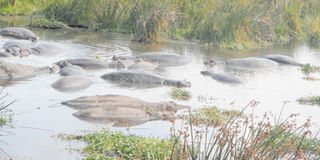The amazing wildlife of Katavi National Park

Hippos grunting and snorting in the pool. One of the attractions in Katavi national park is a hippo population of over 500. PHOTOI ELISHA MAYALLAH.
What you need to know:
- The park is defined by two major landscapes: the valley floor and the two escarpments that border it. The valley floor is mostly flat woodland savannah, dissected by rivers, floodplains, and shallow seasonal lakes. The escarpments vary from sheer cliffs to inselbergs and mountainous areas.
My companion and I recently flew to Katavi National Park from Arusha. Located deep in the southwest of Tanzania, Katavi is an untamed and extremely wild area.
The park is defined by two major landscapes: the valley floor and the two escarpments that border it. The valley floor is mostly flat woodland savannah, dissected by rivers, floodplains, and shallow seasonal lakes. The escarpments vary from sheer cliffs to inselbergs and mountainous areas.
Arriving by a light aircraft part of the flight was defined by long stretches of sparsely inhabited forests and without any sighting of human habitation below.
After the steep Mlele escarpment on the park’s eastern boundary came into view.
We descended in a gentle arc, down to the tiny airstrip, my eyes drawn compulsively to the great floodplains spreading north and south.
We passed over the Katasunga plains before landing, and almost immediately entered the park. By the end of the journey, we were exhausted. But waking up the next day in the most incredible setting made the entire journey seem well worth the effort.
Our safari camp was on the edge of one of the park’s three main marshy plains of the Katisunga.
The scenery here is spectacular, both in scope and drama. The Katuma River flows into palm fringed Chada Lake, an amphitheater framed by the Mlele escarpment.
Wedge-shaped Kipapa hill stands sentinel over herds of animals that roam the park in a never-ending search for grazing.
And far away horizons, bruised purple at dusk, reminded us that we’re tucked under the western arm of the Great Rift Valley.
Katavi, the third largest park in Tanzania has some of Africa’s largest wildlife concentrations in its remote wilderness.
Spread out before us on our first game drive were burnished grasslands covered with thousands of zebra, topi, buffalo, and giraffe. Lions were on the fringes, watching and waiting, shaded by mahogany trees.
Elephants drunk from the river banks, roan, and sable antelope hid in the dense thickets, while vultures cleaned and dried their wings in small streams.
This was our long day in Katavi and we had an immense wilderness all to ourselves.
Katavi is an amazing destination because of its isolation and wilderness, and the unbelievable numbers of wildlife, especially buffaloes and hippos.
Our guide told us that from June to October buffalo herds of up to 3,000 graze on the plains. And our visit coincided with their timing.
“To see the most wildlife, visitors are advised to come in August, at the height of the dry season”, our guide said.
This is the time when we were rewarded with enormous sightings of buffalo herds that roamed the dusty floodplains.
The end of the rains, our guide said, is another magical time, although completely different, with the floodplains tinged soft green, everything fresh and new and animals roaming on the horizon.
On our second game drive, the next day game viewing was of a very high standard. Being a dry season, the animals congregated around the drying waterhole.
In the dry season, particularly between August and November, the Katuma River provides the only source of water in the area, and this draws animals in great numbers.
“As the river shrinks in the heat, the wildlife are forced into an uncomfortable proximity, offering a good chance of seeing many different species at the same time”, our guide said.
As the afternoon fell low we set off for the hippo pool. Over 600 hippo were in dense formation and some were engaged in territorial battles, providing a perfect place for a sundowner.
They spent the whole day in the pool. At night, according to our guide, they ease themselves out of the pool and set off on land, traveling great distances to eat vast amounts of grass to keep them going the following day.
Later, we watched exciting large crocodiles in the mud, marabou storks picked over hippo carcasses and spotted hyena loped off into the distance.
On our last night as we sat in the open fire after-dinner, the savannah spread out in the far horizon before us and the magic of Katavi was so real.
E-mail: [email protected]




